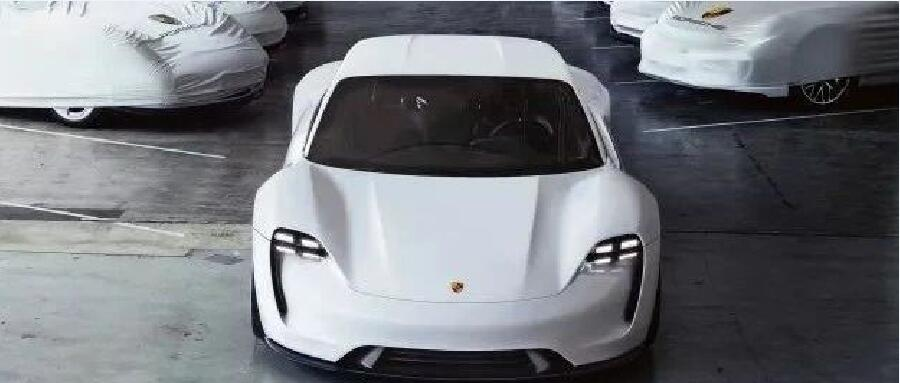Why Porsche?
Let’s start with a question: which traditional car manufacturer has been impacted the most by the rise of Tesla, particularly in North America?
Is it BBA? Probably not. It’s Porsche.
According to Porsche’s Wikipedia page, “Porsche is a German automobile manufacturer specializing in high-performance sports cars, SUVs and sedans.”
We often joke about the natural advantage of electric motors over internal combustion engines in terms of acceleration, and talk about how the Tesla Model 3 is the cheapest car to reach 0-60 mph in 3 seconds. But behind this lies a fact: the electrification of high-performance sports cars and luxury sedans has completely erased the differentiation in pure acceleration between the two markets. The line between high-performance sports cars and luxury sedans is blurred.
The acceleration of the Tesla Model S P100D has surpassed that of the three supercars, the Porsche 918 Spyder, McLaren P1, and Ferrari Laferrari. Of course, “high-performance” is not just about 0-60 mph acceleration. Tesla still has a long way to go in terms of driving quality and chassis tuning. However, without a doubt, the impact of 0-60 mph acceleration on product promotion and sales is evident.
In fact, Porsche was one of the first traditional car manufacturers to recognize Tesla as a real competitor.
At the 2015 Frankfurt Motor Show, Porsche announced that it would launch a purely electric sports car. However, the switch from internal combustion engines to electric motors brought some new challenges to Porsche. Some of the internal combustion engine supporters questioned whether Porsche’s electric vehicles would lose the soul of Porsche driving.
Klaus Zellmer, CEO of Porsche North America, responded: “Porsche intends to redefine high-performance electric vehicles through the Taycan.”
“We’re not simulating the sound of an eight-cylinder engine or other gimmicks. Our goal is that no matter how the power system changes, Porsche will always be the champion of this segment. Our first pure electric sports car will be a classic Porsche, combining our proven performance and daily commuter usability.”
But the challenge facing Porsche is that Tesla has already established a brand image as a “high-performance electric vehicle manufacturer” in consumers’ minds, successfully occupying consumers’ minds.
Klaus Zellmer, who is in Tesla’s North American headquarters, openly expressed his admiration for Tesla early on.
On November 30, 2017, in an interview with CNBC, Zellmer admitted that due to its intelligence and electric properties, some potential Porsche customers are turning to Tesla, which is a respectable competitor.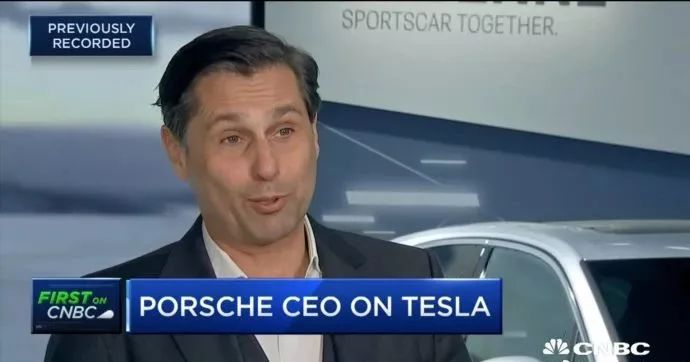
If you look at what Tesla is doing and compare it to their branding value and pricing range, it’s truly astonishing. It’s even more surprising that they’ve achieved this level without relying on a dealer network or real sales organization. Their performance is outstanding.
For Porsche, in order to attract consumers again, Taycan must make some differentiation.
For example, exceeding Tesla in the three electrical systems?
Taycan
Exceeding Tesla in the three electrical systems is not easy, as can be seen from the NIO ES8 and Audi e-tron. It’s not difficult to make the motor performance or battery specifications similar to Tesla, but there are currently no models that can surpass the Model S P100D released in 2016 in terms of comprehensive performance when PK against the three electrical systems.
But it seems that Taycan is aimed at Model S.
Recently, The Drive’s editor, Alex Roy, ordered Taycan. After paying the deposit, Porsche sent an email to Alex, revealing some details.
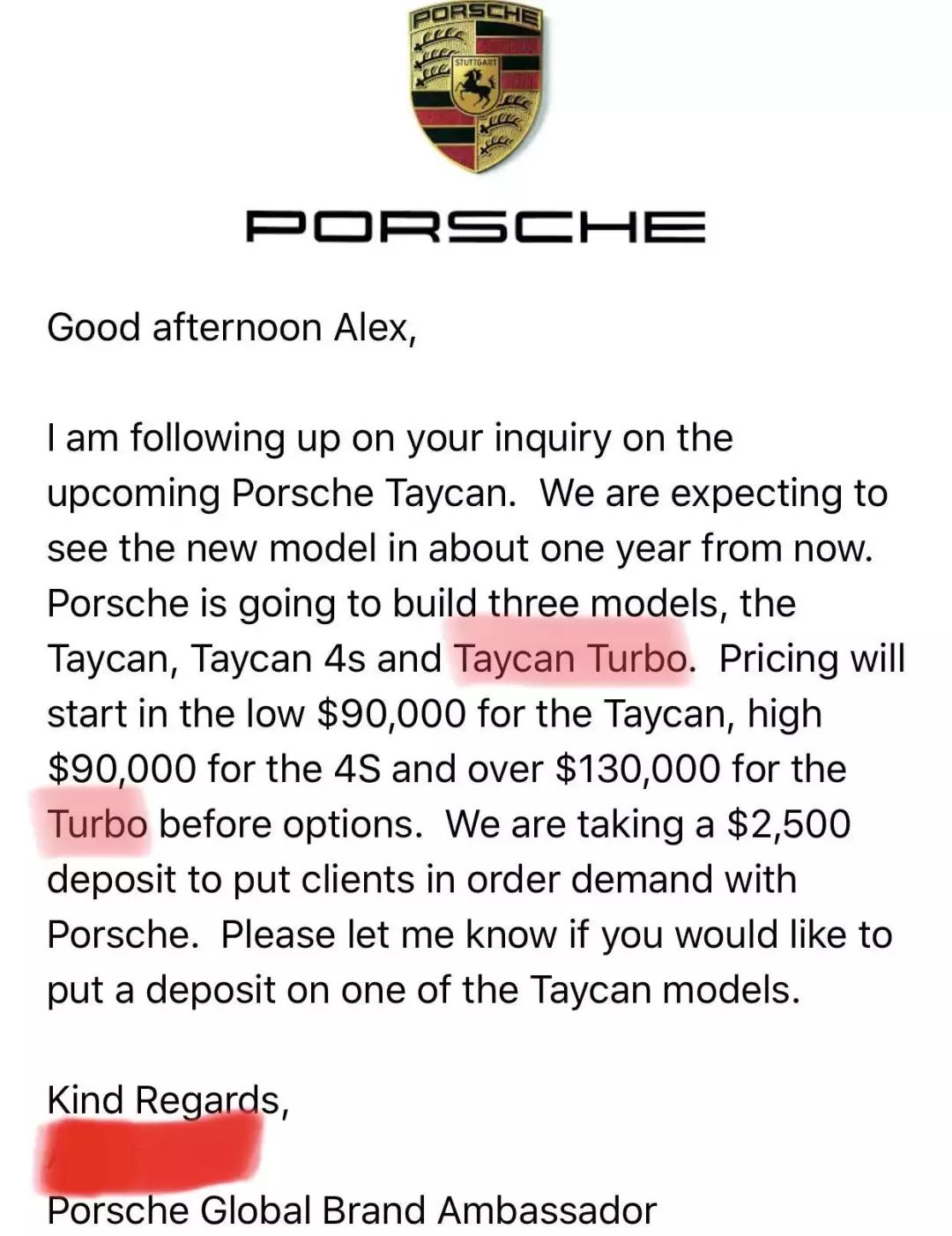
According to the email, Taycan will be divided into three versions: Taycan, Taycan 4s, and Taycan Turbo.
Coincidentally, after multiple adjustments, Tesla Model S product line has only three models left, Model S 75D, Model S 100D, and Model S P100D, which is very interesting.
As for the pricing, Robert Meier, Taycan’s director of vehicle development, previously said that Taycan’s starting price would be between Cayenne and Panamera. The US starting prices of Cayenne and Panamera are $66,000 and $85,000, respectively. Assuming Taycan’s starting price is $75,000, its positioning will be slightly lower than Model S.
However, according to this email, Taycan and Taycan 4s have a starting price of around $90,000, and Turbo has a starting price of $130,000, which is very close to the pricing of Model S’s three models, thus directly forming positive competition.Here is the Markdown text translated into English Markdown format, preserving the HTML tags within it:
Regarding Taycan and its benchmarking against the Model S, there is this picture of two Model S models parked next to the Taycan prototype as Porsche tests it.
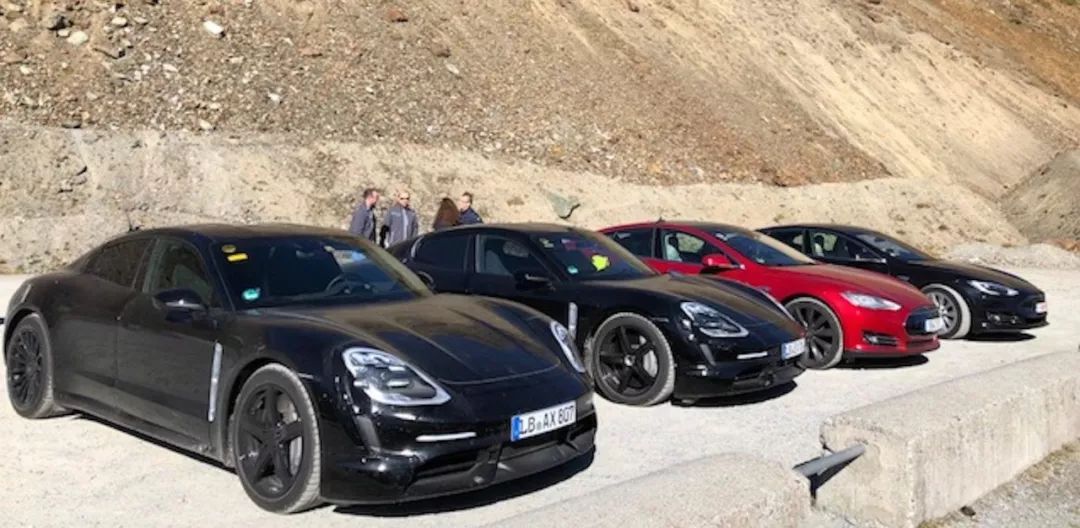
Below is a basic comparison of Taycan and Model S data.
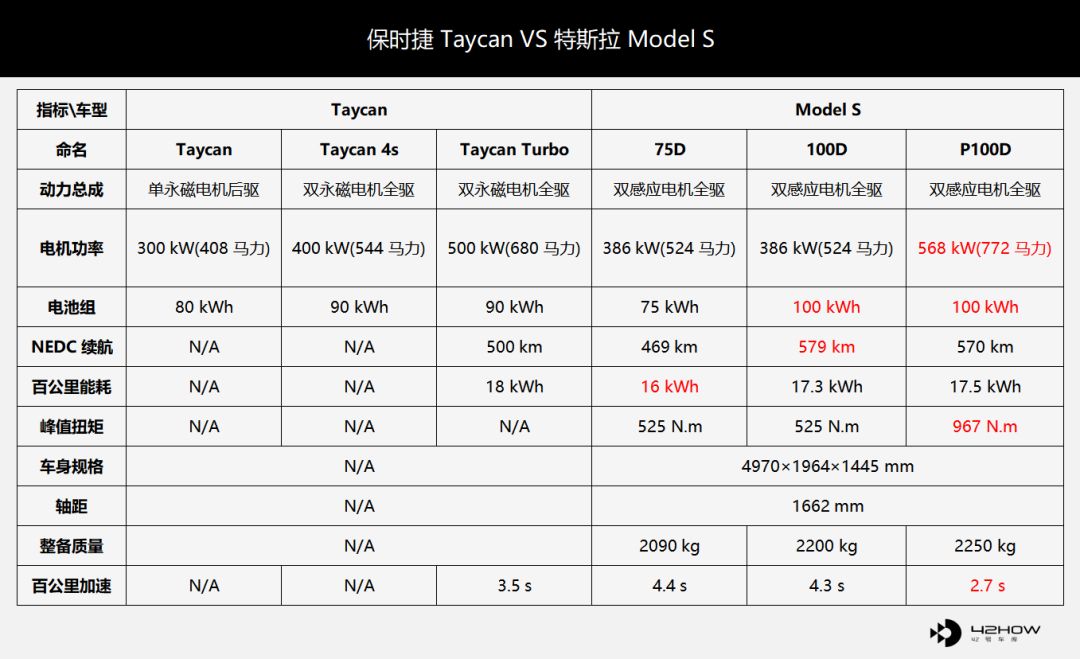
As it won’t be released until the end of next year, Porsche has not disclosed much data about the Taycan. From the data that has been made public, it seems that the Taycan doesn’t have many bright spots. However, there are still many aspects of the triple-electric technology used in this car that are worth exploring.
Contrary to most people’s understanding, although Porsche has not explored the commercialization of electric vehicles like BMW and Nissan for a long time, it has a lot of accumulated technology in the field of triple-electric.
Taycan is a pure electric vehicle developed based on a brand new platform, internally code-named J1. The Audi e-tron GT, Bentley, and Lamborghini’s first pure electric sports cars are all based on the J1 platform, and they are all brother units within the Volkswagen Group. They are based on a unified platform to spread out the R&D investment to expand the scale effect, a very Volkswagen-like strategy.
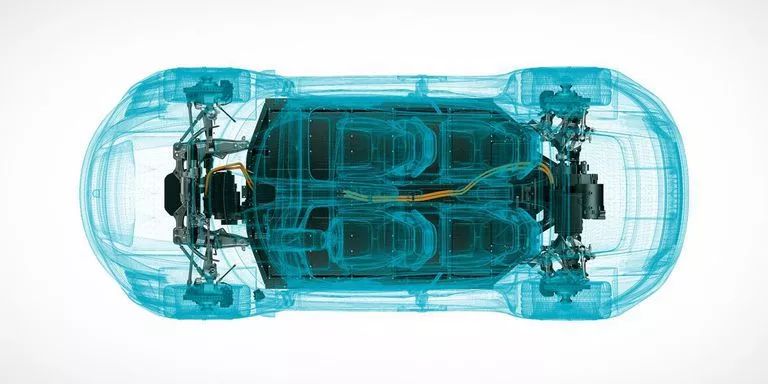
Taycan is equipped with a permanent magnet motor, while the 4s and Turbo models are front and rear dual-permanent magnet motors with all-wheel drive.
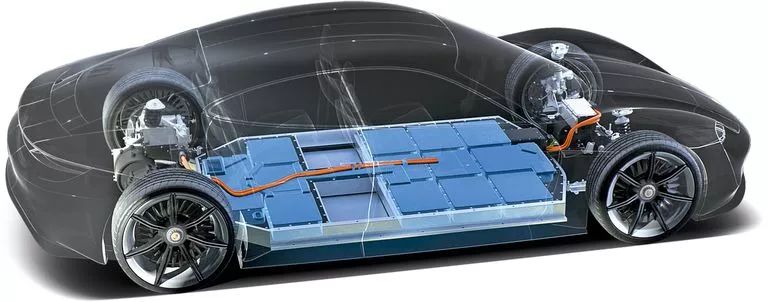
Otmar Bitsche, Director of Electronic and Electrical Development at Porsche, gave three reasons for using permanent magnet motors:
-
Impressive power-to-weight ratio, i.e. low weight and high power
-
Ultra-high torque
-
Sustainable high performance
These three reasons are very interesting. Prior to this, the advantages of permanent magnet motors were high efficiency and economic viability. In the low-speed commuting range, energy consumption is lower, and there is a risk of demagnetization in the high-speed acceleration range.
(Of course, this demagnetization problem has been almost solved. The BYD Tang EV, with a zero to hundred acceleration of 4.4 seconds, also uses a combination of front and rear permanent magnet motors.)But Taycan is different. Stefan Weckbach, Vice President of the Porsche Pure Electric Product Line, emphasized repeatedly that Taycan is committed to achieving consistent and sustainable high performance, and the battery will always be in the ideal temperature range.
Taycan aims to provide a stronger sustainable high-speed driving capability than the Model S P100D, which means that two permanent magnet motors support continuous high-speed operation in high temperature ranges.
Another issue with long-term sustained high-speed operation is rapid energy consumption. Porsche’s solution to this problem is to provide a supercharging station with an output power of up to 320kW.
This technology sounds more hardcore than anything like battery switching for extended range. After all, the third-generation Tesla Supercharging station, to be fully deployed in Q1 2019, has a charging power between 180kW and 240kW.
Tesla CEO Elon Musk also commented on Porsche’s upcoming 320kW fast charging station.
“A 350kW supercharge doesn’t make much sense unless you have a monster battery pack or a very high charge and discharge rate, but then that means the energy density of the battery pack will be very low.”
To translate, for batteries of the same size, the higher the charging power, the more severe the battery heating. Therefore, the “monster battery pack” here should refer to a highly complex, heat-dissipating structure that is also light enough to avoid too much extra weight. Of course, costs would undoubtedly skyrocket, and the technical difficulty would be very high.
The case with Taycan is, in fact, different: the battery has a high discharge rate and can naturally withstand high charging power, but the energy density of the battery is very low.
Joachim Kramer, Director of Porsche Power Electronics, introduced Taycan’s 800V voltage technology in an interview.
“Taycan’s battery pack does not apply any special game-changing chemical materials to achieve high voltage of 800V. Porsche has found an elegant solution by connecting 400V batteries in series, achieving double voltage with half the current for the same input power.”
“Taycan batteries are no different from other 400V electric vehicle batteries, but Taycan pushes the voltage limit of the battery.”
In an interview with Porsche Engineering Magazine, Otmar Bitsche, Director of Porsche Electrical and Electronics Development, was asked the following question: “Applying the latest high-voltage lithium batteries is the gold standard, with an energy density of about 180 Wh/kg. How high can the energy density of batteries be expected in the future?”
Otmar’s answer is not important, what is important is 180Wh/kg, which may be the battery energy density value used by Taycan. Judging from the numerical and high voltage requirements, the cells used by Taycan may be from the NCM 111 route. It basically meets Elon Musk’s claim of having a high charging and discharging rate but low energy density.
However, this raises another question – the lightweighting of Taycan’s battery pack needs to be pushed to the limit, otherwise the curb weight of the whole vehicle will be affected.
But for Porsche, as a professional sports car manufacturer, skilled use of various materials to achieve lightweighting is not difficult. Take the Porsche 919 Hybrid LMP1 for example, this car was the champion in the 2016 Le Mans endurance race. The overall architecture of the car is made of carbon fiber, the engine is made of high-strength aluminum alloy, and many parts of the body are made of magnesium and various titanium alloys, as engineers put effort into lightweighting the whole car.

It is not that Taycan will use a carbon fiber body, but this car can prove that Porsche is already quite familiar with achieving extreme lightweighting in relative cost structures.
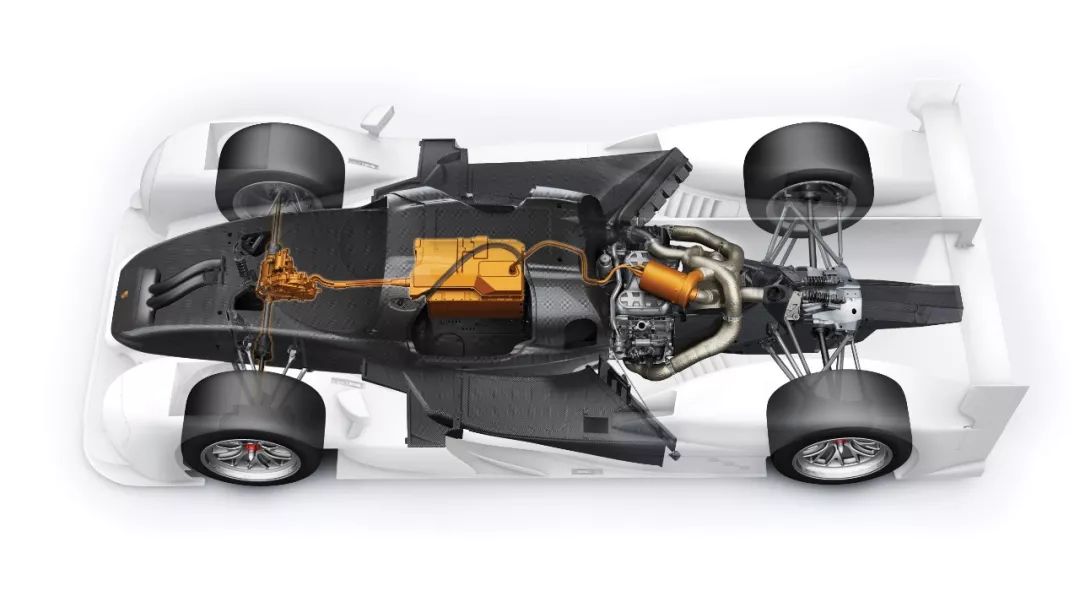
In addition, the 919 Hybrid LMP1 is actually Porsche’s first vehicle to adopt an 800V high-voltage battery, and Taycan’s high-voltage battery is derived from it.
Moreover, the 800V high-voltage battery also achieves weight reduction in wiring harnesses. Compared to 400V battery models, Taycan’s transmission loss of all copper cable wiring harnesses is only 1/4 of the former, as the transmission current is much lower. This enables the copper wiring harnesses of Taycan to reduce weight by 88 pounds (about 40kg).
There are still many challenges to achieve 320kW fast charging, including the development and adaptation of components such as motors, frequency converters, and on-board chargers. In Kramer’s words, except for the battery, all components related to “electricity” in Taycan are different from other electric vehicles.The lightweight technology of top sports cars, the pioneering 800V high-voltage fast charging… Now you know why Taycan’s starting price has increased from $75,000 to $90,000, don’t you?
Taycan’s strategy is worth learning from by BBA. As mentioned earlier, if it is a comprehensive performance comparison of the three electric power systems, Porsche is unlikely to win against Tesla. Not to mention Tesla’s killer advantage in terms of intelligence. Facing such a strong competitor who excels in technology and engineering innovation, Taycan chooses to highlight the absolute pain point of Porsche-style manipulation + pure electric vehicle experience, which is the super-fast charging.
Tesla’s biggest shortcoming is workmanship and reliability. Why didn’t Porsche mention it? When you purchase a Porsche, it is definitely not because of its good workmanship. The workmanship of Mercedes-Benz, BMW, and Audi are also good. Only Porsche’s unique configuration or better experience than competitors can persuade consumers.
According to Klaus Zellmer, the enthusiasm of users’ reservations is “very amazing”. If all reservations can be converted into orders, our first year’s production capacity will be sold out.
More than half of Taycan’s reservation users are not Porsche owners, but Audi, BMW, and Mercedes-Benz owners. And at the top of the list are Tesla owners.
The Porsche Mission E, renamed Taycan, will enter China in 2020.* The coolest challenger of Tesla has arrived: Audi e-tron GT

This article is a translation by ChatGPT of a Chinese report from 42HOW. If you have any questions about it, please email bd@42how.com.
